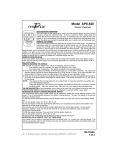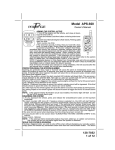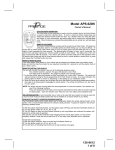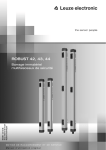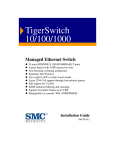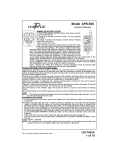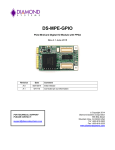Download Audiovox 128-8146 Automobile Alarm User Manual
Transcript
Model APS-520 Owner’s Manual ARMING THE SYSTEM - ACTIVE 1. Turn off the engine, exit the vehicle, and close all doors, hood lid and trunk lid. 2. Press and release Lock/Arm button on the keychain transmitter. The dash mounted LED begins to flash slowly. Parking Lights flash one time. Siren sounds one chirp. If the siren/horn sounds 3 chirps, then you have left a door, trunk, or hood lid ajar. Simply close the opened entry point to provide full protection. If the siren "chirped" three times, sometime after arming, the exclusive, patented, delayed dome light learn circuit has been programmed and the system detected a open entry point after the learned delay expired. Again, closing the hood, trunk, or doors will correct the problem and you do not need to disarm the system to make the correction. If the siren/horn did not sound when arming, then the chirps have been turned off and you should refer to the section titled "ELIMINATING THE ARM/ DISARM CHIRPS" in this manual. NOTE: If selectable feature 9, Chirp Delete From Transmitter, was set to the on position during installation, then you can selectively defeat the arm & disarm chirps by holding the transmitters Lock or Unlock button for about 2 seconds. Note: If Passive Arm Mode was selected on during installation, then 30 seconds after the last vehicle door is closed, the unit will arm automatically. PROTECTION WHILE THE SYSTEM IS ARMED Opening any protected door, hood or trunk lid will cause the alarm to immediately sound. The alarm will continue to sound for 30 seconds, then stop and continue to monitor all protected entry points. If the thief left a door opened, the alarm will sound for six 30 second cycles, remain armed and ignore that triggered zone.\ Whenever the system is armed, the dash mounted LED indicator will slowly flash. This serves as a visual deterrent to the potential thief. The LED is a very low current bulb and will not cause the vehicle’s battery to drain, even when left unattended for extended periods. Whenever the system is triggered, the vehicle’s parking lights will flash for the full 30 second alarm cycle, attracting visual attention to the vehicle. Optional - Whenever the system is armed, the vehicle’s starting circuit will be bypassed. If the thief should choose to ignore the siren, the vehicle can not be started. Any mild impact to the vehicle’s glass will cause the alarm to sound a short series of warning tones. Any strong impact to the vehicle’s glass will cause the alarm to trigger for the full 30 second alarm cycle. NOTE: If the optional interior illumination circuit was installed, the interior light will flash as well for the full 30 second alarm cycle. DISARMING THE SYSTEM 1. As you approach the vehicle, press and release the Unlock/Disarm button on the keychain transmitter. The dash mounted LED turns off. If passive arming is selected on, the LED will start flashing rapidly, indicating that the system is re-arming automatically. Open any door to suspend the automatic arming. Parking Lights flash two times. If the parking lights flashed three times, then the alarm was triggered in your absence. Before turning the key on, examine the LED to identify which zone was triggered. Siren sounds two chirps. If the siren sounds 4 chirps, then the alarm was triggered in your absence. Before turning the key on, examine the LED and refer to the INTRUSION WARNING SIGNALS section of this manual to identify which zone was triggered. If the siren did not sound when disarming, then the chirps have been turned off and you should refer to the section titled “ELIMINATING THE ARM / DISARM CHIRPS“ in this manual. Doors Unlock - Optional NOTE: If the optional Interior illumination feature has been added as an added convenience, the system will turn on the interior lights when the system is disarmed. WHILE THE SYSTEM IS SOUNDING If during a triggered state, you wish to shut off the siren without disarming your security system, simply press and release any transmitter button other than the Unlock/Disarm button. This action will turn off the siren yet leave the vehicle fully armed and protected. This feature is particularly useful if you are aware of children playing near your vehicle that may accidently trigger your security system. In this case you can cancel the siren sounding without disarming your alarm. INTRUSION WARNING SIGNALS This system will inform you if an intrusion attempt has occurred while you were away from the vehicle. If an Page 1 128-8146 1 of 8 intrusion attempt has occurred, the siren will chirp 4 times and the parking lights will flash 3 times when disarming the system. Enter the vehicle and observe the red dash mounted LED to identify which zone was triggered. 1. If the LED is flashing one time...pause...one time...pause...etc., then an intrusion attempt was made to the shock sensor, or an accessory triggering device that may have been added to the system. 2. If the LED is flashing two times...pause...two times...pause...etc., then an intrusion attempt was made to a hood or trunk pin switch that was added to the system or to a light activated entry point if the alarm was installed using the voltage sensing feature. 3. If the LED is flashing three times...pause...three times...pause...etc., then an intrusion attempt was made through one of the vehicle’s doors. These intrusion warning indicators are stored in the system’s memory and will only be erased when the ignition key is turned on. VALET SWITCH The valet switch allows you to temporarily bypass all alarm functions, eliminating the need to hand your transmitter to parking attendants or garage mechanics. When the system is in valet mode, all alarm functions are bypassed, however the remote panic feature and remote door locks will remain operational. In addition, the parking lights will flash to indicate locking and unlocking. To use the valet mode, the system must first be disarmed either by using your keychain transmitter or by activating your personalized manual override code. 1. Enter the vehicle and turn the ignition key to the on position. 2. Press and hold the valet pushbutton switch until the dash-mounted LED turns on solid. The system will remain in the valet mode. 3. To return to normal operation, press and release the pushbutton switch any time the ignition is on. NOTE: Always remember to return the system to normal operation. This will ensure that the vehicle remains protected at all times. MANUALLY OVERRIDING YOUR SYSTEM: USING THE VALET SWITCH MANUAL OVERRIDE Your Security System can be disarmed without the use of the keychain transmitter. This is necessary, since you will need the ability to operate your vehicle if the transmitter is lost or its battery fails. If your system has been selected for Valet Switch manual override as indicated on the last page of this manual, to bypass the alarm system; 1. Open the vehicle door. The alarm will sound. 2. Turn the ignition key to the on position. 3. Within 5 seconds, press and release the valet pushbutton switch. The alarm system will stop sounding and enter the (bypass) mode. You can now start and operate the vehicle normally. Typically this override mode is used only if the transmitter has become inoperative. PROGRAMMING YOUR CUSTOM OVERRIDE CODE: Unlike override switches easily found, and defeated, this security system allows the consumer to program a personal override code, offering a higher level of security. To take advantage of this option, programmable feature # 10 must be selected for the Custom Code Option. Consult your installation center for programming details. The system comes from the factory with a pre-programmed override code of 11. To change this default override code, do the following: 1. Disarm the system by use of the transmitter, or by use of the emergency override sequence. Turn the ignition switch to the on position. 2. Within 10 seconds, press and release the valet/override switch, 3 times. 3. Within 10 seconds turn the ignition switch off, on, off, on, off, on. (The siren or horn will beep and the lights will flash one time with each ignition switch cycle.) 4. Within 10 seconds, begin to enter your chosen 10ths digit by pressing and releasing the pushbutton switch from 1 up to 9 times. 5. Within 10 seconds of the last entered 10ths digit, turn the ignition switch off then on. 6. Within 10 seconds, begin to enter your chosen units digit by pressing and releasing the pushbutton switch from 1 up to 9 times. 7. Finish by turning the ignition switch to the off position. If the new code was accepted, the unit will report back the newly entered code, by flashing the LED, first indicating the 10ths digit, pause and then the units digit. The unit will report the new code three times with a one second pause between each code, then the system will begin arming. If the LED flash pattern reports the previously stored code, the new code was not entered correctly. Please repeat steps 1 through 7 above considering the following. NOTE: Acceptable digits 10ths or units are 1 through 9. The unit will not recognize a 0 (Zero), or no digit entered in any place, units or tenths. NOTE: If 15 seconds of inactivity expire or if the ignition switch is turned off for more then 5 seconds during any of the above steps, the unit will revert back to the last successfully stored code. Custom Code Programming Example: To Change the code from the factory pre-assigned code of 11 to “52” you would do the following: 1. Disarm the system by use of the transmitter or by use of the emergency override sequence. Page 2 128-8146 2 of 8 2. Turn the ignition switch to the on position. 3. Within 10 seconds, press and release the valet/override switch, 3 times. 4. Within 10 seconds turn the ignition switch off, on, off, on, off, on. (The siren or horn will beep and the lights will flash one time.) 5. Within 10 seconds, begin to press and release the pushbutton switch to set the tenths digit. (As per the example, press and release 5 times to set the tenths digit to 5) 6. Within 10 seconds of the last press of the pushbutton, turn the ignition switch off then on. 7. Within 10 seconds, begin to press and release the pushbutton switch to set the units digit. (As per the example, press and release 2 times to set the units digit to 2). 8. Turn the ignition switch to the off position. Immediately observe the LED flash pattern. You will note the LED flashing five times, pause, and then flash two times, pause. This pattern will be repeated three times indicating the new code (52) has been accepted and stored in memory. NOTE: If after step 7, the LED flashes a code other than what was just entered, this indicates that the code has not been changed. You will have to repeat steps 1 through 7 above being certain to note the following: Acceptable digits 10ths or units are 1 through 9. The unit will not recognize a 0 (Zero), or no digit entered in any place, units or tenths. NOTE: If 15 seconds of inactivity expire, or if the ignition switch is turned off for more then 5 seconds during any of the above steps, the unit will revert back to the last successfully stored code. MANUALLY OVERRIDING YOUR SYSTEM: USING THE CUSTOM CODE OVERRIDE Assuming the override code programmed has not been changed, and the default override code of 11 is in the system's memory. 1. Enter the vehicle and turn the ignition switch to the on position. NOTE: The siren will sound. 2. Within 5 seconds, press and release the pushbutton switch 1 time. 3. Within 5 seconds, turn the ignition switch off then on. 4. Within 5 seconds, press and release the pushbutton switch 1 time. 5. Turn the ignition switch off then on and start the vehicle. NOTE: If you have changed the programmed override code then substitute your new code tenths for step 2 above, and units for step 5 above. REMOTE CAR FINDER/PANIC The Lock or Unlock buttons are also used to access the car finder/panic mode. This feature is particularly useful in a crowded parking lot where finding your car may be difficult to locate, or if there are suspicious characters hanging about your vehicle. To access this mode, while within range of your car, simply press and hold either the lock or unlock button of your transmitter for three seconds. The parking lights will begin to flash, the siren will sound, and if connected, the vehicle horn will beep making your vehicle audible as well as more visible. The lights, siren and or horn will stop automatically after 30 seconds. If you wish to turn off this mode prior to the expiration of the 30 second timer, press and hold for three seconds either the lock or unlock buttons a second time, or press and release the Trunk/Start button one time. REMOTE TRUNK RELEASE If you have electric trunk release in your vehicle and the remote trunk release option was added, simply press and hold the Key/Trunk button of your keychain transmitter for 3 seconds or until the electric trunk of your vehicle opens. . . THE OPTION BUTTON of your transmitter may or may not be used with your system but may be used with a second similar Audiovox Model system that may be installed on a second vehicle in your family. ELIMINATING THE NORMAL ARM / DISARM CHIRPS As explained earlier in the manual, you can eliminate the chirps selectively any time you arm or disarm the system, if the feature has been activated, simply by holding the ARM or DISARM button for two seconds. If you find the normal arming and disarming chirps annoying, they can be turned off permanently, eliminating the need to hold the ARM / DISARM button for 2 seconds. To do this: 1. Turn the ignition key on then off. 2. Within 10 seconds, press and release valet switch three times. 3. If the chirps were on before you started, then you will hear two chirps indicating they have been turned off. If the chirps were off before you started, then you will hear one chirp indicating they have been turned on. NOTE: Whenever the chirps are bypassed, the 4-chirp intrusion indicator and 3 chirp defective zone indicator will always operate. Since these are important warnings to you that something has happened, they cannot be eliminated. NOTE: Your system must be programmed by the installation center to enable this feature. RF SHOCK SENSOR MODE SELECTION The way in which your alarm system reacts to threatening vibrations, created by attempts to enter the vehicle by breaking a window, is adjustable by the transmitter immediately after arming. There are 4 modes of operation Page 3 128-8146 3 of 8 that can be selected by the operator: 1. Normal Operation (default mode) In this mode, any strong vibrations will cause the siren to sound (full detect) for 30 seconds. Any lesser vibration will cause the siren to emit about 6 short warn away chirps, (pre-detect). 2. Stage 1 (Omit pre-detect) In this mode, the warn away chirps created by the lesser vibration will be deleted. If strong vibration occurs, the siren will sound. 3. Stage 2 (Omit pre & full detect) In this mode, both the pre-detect stage and the full trigger stage of the sensor are defeated. The unit will not react to vibration of any magnitude. 4. Stage 3 (City Mode) In this mode, the pre-detect chirps will change from six pre-warning tones to a full 10 seconds of warning chirps. The full detect trigger duration will be reduced from 30 seconds to 15 seconds. NOTE: Setting the stage of the shock sensor will be effective for one arming cycle only. Once the system has been disarmed, the very next arming cycle will cause the sensor to default to the normal operation stage. To change or adjust the shock sensor, press and release the ARM button of you keychain transmitter. 1. Within 2 seconds of arming, press and release the ARM button 1 time, to defeat the pre-detect stage of the shock sensor. (The lights will flash and the siren will chirp twice.) 2. Within 2 seconds of step 1, press and release the ARM button 2 times, to defeat the pre and full detect stages of the shock sensor. (The lights will flash and the siren will chirp three times.) 3. Within 2 seconds of step 1, press and release the ARM button 3 times to enter the "City Mode" of operation. (The lights will flash and the siren will chirp four times.) While under control of the remote start the system can be programmed to allow you to shunt the shock sensor from the transmitter. If the system has been such programmed, simply press the lock button of your keychain transmitter anytime during the remote start cycle. The shock sensor will be shunted for the entire run cycle and will resume normal operation after the remote start unit shuts off. Check with your installation center to determine if this feature has been programmed into your system. OPTIONAL DEVICE OUTPUT ( CHANNEL 3 ) Controlled By: Trunk/Key Button Other Transmitter button configurations are also available. Consult your installation center for other configurations not listed above that may have been programmed to operate a specific feature of your system. This security system is equipped with an output which will activate when the appropriate transmitter button is depressed for 3 seconds. Although this output is intended to activate the trunk release option, any other optional devices may be connected to this channel. Consult your installation center for more information about this output. ADDITIONAL REMOTE FUNCTION ( CHANNEL 4 ) Controlled By: Option Button Other Transmitter button configurations are also available. Consult your installation center for other configurations not listed above that may have been programmed to operate a specific feature of your system. This security system has an additional feature that can be connected to a number of different optional accessories. Some of the more common uses for this channel are; * Remote Window Closure, * Remote Garage Door Interface, To remotely operate the device indicated, momentarily press, or press and hold the appropriate transmitter button(s) as indicated above. PROGRAMMING TRANSMITTERS: At times it may become necessary to program replacement or additional transmitters for use with your system. To do this: 1) With the system unlocked or disarmed, turn the ignition key to the on position. 2) Press and release the pushbutton switch three times The unit will flash the parking lights and or beep the horn once to indicate that the system is in the transmitter program mode. The LED will also flash one time pause, one time pause, etc... indicating that you are in the transmitter program mode of the unit’s channel 1 or single button program mode. 3) Press and hold the lock button of each additional transmitter you wish to operate your system. NOTE: The unit is capable of storing up to 4 transmitters. If a fifth transmitter is added, the first transmitter programmed will be bumped out. Once all transmitters have been programmed, turn the ignition switch off to exit the program mode. The system allows priority button programming in case you intend to operate two vehicle with one transmitter. In this instance you will program the default button combination, (One Button Programming), for the main vehicle you drive, and a different combination for the second vehicle so you are not unlocking, locking, or starting both vehicles when they are within range of each other. To prioritize transmitters after programming the transmitter into the first vehicle: Enter the transmitter program of the second vehicle as above by: 1) With the system unlocked or disarmed, turn the ignition key to the on position. Page 4 128-8146 4 of 8 2) Press and release the pushbutton switch three times The unit will flash the parking lights and or beep the horn once to indicate that the system is in the transmitter program mode. The LED will also flash one time pause, one time pause, etc... indicating that you are in the transmitter program mode of the unit’s channel 1 or single button program mode. 3) Press and hold any combination of buttons of your transmitter that was not used for your primary vehicle. If, for instance you can press & hold the lock & unlock buttons simultaneously, for controlling Lock function of the second vehicle. 4) Press and release the program pushbutton switch once to advance to channel 2, unlock. Here you can press and hold the lock & start buttons simultaneously, for controlling the unlock function of the second vehicle. 5) Press and release the program pushbutton switch once to advance to channel 3, start. Here you can press and hold the start & option buttons simultaneously, for controlling the start function of the second vehicle. DELETING TRANSMITTERS FROM YOUR SYSTEM: It may be necessary to delete a lost transmitter or to reprioritize a transmitter that is programmed to your system. To remove a transmitter that has been programmed in your system: 1) Enter the transmitter program mode of channel 1 as indicated above. 2) Press and hold any transmitter button that has not been programmed into channel 1 until you hear a chirp, then release and immediately press the same button a second time until you hear a long chirp followed by a short chirp. This action erases the transmitter. If the transmitter you wish to erase has been lost or stolen then following the information below will successfully remove the transmitter. NOTE: For this procedure, you must have all transmitters you wish to remain programmed in your system available. 1) Enter the transmitter program mode of channel 1 as indicated above. 2) Press and hold the lock button of each transmitter you wish to operate the lock function of your unit making sure you occupy all 4 transmitter slots. In other words, you have three transmitters you wish to remain programmed. Press and hold the lock button of transmitter one until a long chirp is heard, then press and hold the lock button of transmitter two, then press and hold the lock button of transmitter three, followed by pressing and holding the lock button of transmitter one again. This action fills all 4 receiver slots. 3) Advance to receiver channel 2 by pressing the pushbutton switch one time. 4) Press and hold the unlock button of each transmitter you wish to operate the unlock function of your vehicle, again making sure all 4 transmitter slots are filled. 5) Advance to receiver channel 3 by pressing the pushbutton switch one time. 6) Press and hold the unlock button of each transmitter you wish to operate the start function of your vehicle, again making sure all 4 transmitter slots are filled. If you are uncomfortable about the programming of additional transmitters as outlined in the processes above please contact your installation center or call the technical service number listed on the back of the transmitter for help. BATTERY REPLACEMENT The transmitter incorporates a small LED visible through the case which is used to indicate battery condition. You will notice a decrease in transmitter range as the battery condition deteriorates. Transmitter battery replacement is recommended at least every 10 to 12 months, depending upon how frequently the transmitter is used. To replace the battery in the 620TX: 1) Remove the small # 0 Phillips head screw from the rear of the case. 2) Remove the rear cover to access the discharged battery paying attention to the proper polarity orientation. 3) Carefully remove and properly dispose of the discharged battery. 4) Insert the new battery, close the case, then reinstall the small case screw removed in step 1. 5) If you accidently dislodge the circuit board from the transmitter housing, be certain that the rubber membrane is seated properly, and the buttons are properly exposed from the front view of the case, then insert the circuit board, and return to step #4. 620TX Uses GP23 Battery To replace the battery in the 920TX there is a slide off battery cover on the rear of the transmitter. Lift the edge of the door slightly and slide the cover off. Remove the discharged AAA battery and replace with a fresh one, then replace the battery cover. 920TX2 Uses AAA Battery Page 5 128-8146 5 of 8 FEATURES AND FUNCTIONS OF YOUR TWO WAY LCD 920TX2 Doors are locked Icon. If the system is armed “ ARM “ will also appear below the Lock Icon. Doors Unlocked Icon. Valet Mode. When Transmitting, any button activated. Within Range Indicator. Timed Start Activated. Someone Paging You From Your Vehicle. Vibrate Mode Is On. Toggle feature on and off by pressing Trunk/Key + * buttons for 5 seconds until beep is heard, then press the Unlock Button Once. Battery Save Mode Is On. Battery Level Indicator, Shown At Full Level. Hood Or Trunk Input Was Activated. Door Input Was Activated. Vibration Sensor Was Activated. Pre Detect Stage Of Sensor Was Activated. Valet Mode Is Activated FCC NOTICE This device complies with part 15 of the FCC rules. Operation of this device is subject to the following conditions: (1) This device may not cause harmful interference, and (2) This device must accept any interference received, including interference that may cause undesired operation. Caution: Changes or modifications not expressly approved by the party responsible for compliance voids the users authority to operate this device. Page 6 128-8146 6 of 8 ORDER FORM FOR 620TX & 920TX2 Attention: Transmitter Ordering Department Important: To help us expedite your order, please print all of the information legibly and mail this form and your payment according to the instructions below. Note: Transmitter model number found on back of case. 620TX 920TX2 1) Transmitter Model Number_____________________ 2) Name: _______________________________________ 3) Address: ______________________________________ 4) City: ________________ State: _____ Zip Code: ________ 5) Telephone Number: (_____) _______________ 6) Total Number Of Transmitters Required 620TX: Cost Per Transmitter is: $65.00 Multiply By Number Of Transmitters X ______ OR Total Number Of Transcievers 920TX2: Cost Per Transceiver is: $85.00 Multiply By Number Of Transceivers 7) Enter Total Amount Enclosed _________________ X______ New York State Residents must include the appropriate sales tax) 8) Method of Payment: Mastercard Visa Check or Money Order (do not send cash) Make Checks Payable To Audiovox Corporation Credit Card Number: _________________________________ Credit Card Expiration Date: ____ / _____ / _____ Credit card purchasers can order additional or replacement transmitters by phone. Simply dial 1 - 800 - 645 - 4994, and follow the instructions from the operator interface. 9) Mail this form along with your payment to: Audiovox Electronics Corp., 150 Marcus Blvd., Hauppauge, N.Y., 11788 Attn.: TRANSMITTER DEPARTMENT Page 7 128-8146 7 of 8 © 2007 Audiovox Electornics Corporation, 150 Marcus Blvd., Hauppauge, N.Y., 11788 128-8146 Page 8 128-8146 8 of 8









